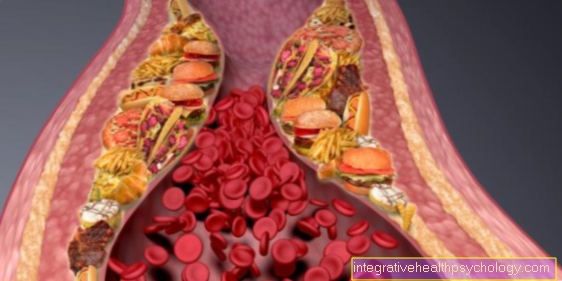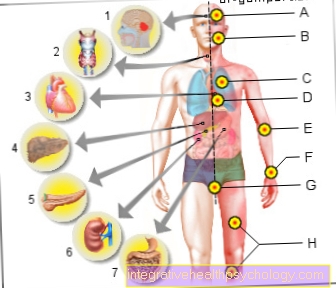Ebola
introduction
Ebola is viral Infectious diseaseincluded in the group of "haemorrhagic fevers" (i.e. infectious fevers in which bleeding occurs).
Overall, it occurs rarely, but occurs in the majority of cases fatal. Depending on the subspecies of the virus, the mortality rate from Ebola is 25-90%. A causal therapy does not exist yet.

The name of the disease comes from the Ebola River which is located in the Democratic Republic of the Congo. There it came 1976 to the first major known Ebola outbreak.
Suspected Ebola virus infection, a secured disease as well as the death as a result of the disease are in Germany by name notifiable. So far there have been no new cases in Germany.
Epidemiology
So far, Ebola has been the most common case in sub-Saharan Africa. The states affected were mainly Zaire, Uganda and the Democratic Republic of the Congo.
In 2015 there was a major Ebola epidemic in West Africa, which was concentrated in Sierra Leone, Guinea and Liberia, but also affected Senegal, Nigeria, the Democratic Republic of the Congo and Mali. At the time of the epidemic, there were fears that it would spread around the world, which ultimately did not occur. Mali, Nigeria, Liberia, Sierra Leone and Guinea are currently considered Ebola-free again. So far there have been no cases of illness in Germany.
You may also be interested in this topic: Coronavirus- how dangerous is it?
Ebola virus
The Ebola virus belongs to the genus Filoviridae.
The virus can be divided into five subspecies: Zaire, Sudan, Taï Forest, Bundibugyo, and Reston. Only with the Reston subspecies is there no danger to humans, since this virus does not affect humans.
After infection, the virus docks on the human body cells, penetrates them and multiplies. The virus can use almost all human body cells for its reproduction. The newly generated virus particles are then released from the infected body cells and the virus continues to spread in the organism.
The Ebola virus is one of the RNA viruses and, with its diameter of 80 nm, is one of the largest representatives.
Read more on the topic: What is the Ebola Virus?
Where is the origin of Ebola?
The Ebola virus was first detected in 1976 in what is now the Democratic Republic of the Congo. The virus is named after the Ebola River, near which the first known outbreak occurred in 1976. Back then, the disease was transmitted through contaminated needles and syringes in hospitals. The exact natural host of the Ebola virus is not known, but it is believed that the virus is mainly transmitted to humans by bats and fruit bats. The first sick patient in the major epidemic, which began in 2014, was a young boy from a village in Guinea who was believed to have come into contact with bats on a hollow tree. By examining the DNA found on the tree, it was found that a species of bat known to be the carrier of the Ebola virus had lived there.
Causes of Ebola
Ebola is caused by the infection caused by the Ebola virus.
It is transmitted from infected people or animals to other people or animals. Also contaminated objects and food, for example Bush meat, can cause disease on contact. Obviously, in areas where the virus is endemic, there is a greater risk of infection.
transmission
The Ebola virus is transmitted by Person to person, from Animal to human or from contaminated objects or food on humans.
The natural reservoir of the pathogen has not yet been identified beyond doubt, but is found in certain genera of Fruit bats supposed. As a transmission route from the fruit bats to other animals and humans Fruits and leaves suspected, which are wetted by the excrement and the saliva of infected fruit bats and ultimately consumed by other animals or humans.
The transmission from person to person usually takes place through direct contact with body fluids infected people, for example through contact with vomit, blood, stool or saliva. Tears, semen, breast milk and sweat also contain relevant amounts Virus rna and can be used as infectious body fluids.
Usually the pathogen is transmitted via the mouth, or the Gastrointestinal tract recorded. Also about the Conjunctiva infection is possible.
The Droplet infectionIn contrast, infection through sneezing or coughing by an affected person should not be a major transmission path for the disease. If, however, large amounts of pathogen are expelled through sneezing or coughing, which then directly affect someone who has not yet been ill, it can very well lead to infection.
Hygiene precautions are therefore the most important measure to contain Ebola fever in order to protect people who have not yet been infected from infection. Before the first symptoms of the disease appear, people infected with the Ebola virus are not contagious.
These symptoms can indicate Ebola
The time between infection with the Ebola virus and the onset of the actual disease is usually around 8-10 days, but it can also be 5-20 days.
The Ebola fever then traditionally runs in two phases.
The first phase is reminiscent of a flu-like infection. Patients initially develop a fever, chills, headaches and aching limbs. Nausea and vomiting can also occur. Furthermore, it can lead to diarrhea, dizziness, general weakness, loss of appetite, sore throat and conjunctivitis.
After this first phase of the disease subsides, the symptoms usually improve for about 24-28 hours before the second phase of the disease begins. This is characterized by the characteristic bleeding that makes up hemorrhagic fever. Patients develop a high fever again and show different bleeding symptoms.
These range from Bleeding into the conjunctiva about bleeding in the Gastrointestinal tract to bleeding in kidney and Urinary tract. The bleeding often manifests itself through bloody stool and or urine.
It also occurs in severe and prognostically unfavorable courses Coughing up blood (hemoptysis) and Vomiting of blood (hematemesis).
Symptoms from impairment of the central nervous system are described, for example Seizures, confusion and comatose states.
Some patients develop Bleeding into the skin and widespread rashes. In the process it comes to Kidney failure, Shock and finally to one multiple organ failure. This leads to tissue destruction (Necrosis) in multiple organs and eventually cardiac arrest.
Hemorrhagic fever as a symptom
Hemorrhagic fever is not a symptom. The term "hemorrhagic fever" covers infections that are triggered by different viruses.
In addition to Ebola fever, the group of hemorrhagic fevers includes yellow fever and dengue fever. In addition to the various viruses that trigger them, the respective diseases also differ in their course form. Some of the haemorrhagic fevers are acute, such as Ebola, and others have a more gradual onset.
Vaccinations currently exist for dengue fever and yellow fever. A vaccine against the Ebola virus is currently still in the testing phase.
Please also read the paragraph on Ebola vaccine
Course of disease
The time from infection with Ebola to the onset of the disease and the appearance of the first symptoms is relatively variable and, as mentioned above, is between 5 and 20 days, but mostly 8 to 10 days. At the beginning of the disease, the infected suffer from rather unspecific symptoms that resemble flu.
There are sore throats, headaches, joint and muscle pains, high fever, which can reach up to 41 ° Celsius, and the associated chills. In addition, the eyes may be red and a rash may develop. If the disease progresses slightly, these general symptoms can remain until the end of the infection.
However, if it comes to the severe, hemorrhagic form, life-threatening symptoms occur in addition to these general symptoms. In the hemorrhagic form, there is a pathologically increased tendency to bleed, the so-called hemorrhagic diathesis. This tendency to bleeding is visible through small punctiform hemorrhages in the skin, also called petechiae. This form of the disease can be fatal, especially due to internal bleeding. These primarily affect the gastrointestinal tract and manifest themselves in severe bloody diarrhea. External bleeding from the eyes and mouth also contributes to blood loss. If the sick person is not treated adequately at an early stage by carrying out plenty of fluids and, in the event of blood loss, blood transfusions, the circulation collapses and the patient dies as a result of the resulting organ failure.
What are the chances of survival in the event of an infection?
The mortality of the patients suffering from Ebola is very high. In the last major outbreak in West Africa, around 40% of those infected died. One should bear in mind, however, that this extremely high mortality rate is a result of the conditions in West Africa.
Medical care is inadequate and the sick do not receive the appropriate volume or blood transfusions. In addition, the spread of the virus is favored by the poor hygiene in the hospital facilities.
The chance of survival in the case of Ebola is probably higher in the industrialized nations than in the West African countries due to better and nationwide available health care.
Diagnosis
To unequivocally prove an infection with the Ebola virus, it is not enough to have the clinical condition to assess the patient as the presentation is very similar to infection with others hemorrhagic viruses can be.
To secure the diagnosis, will Body secretions of the sick patient, for example saliva, urine or blood. This must be in one Level 4 high security laboratory examined under the highest security precautions. A PCR (Polymerase chain reaction; Polymerase chain reaction), whereby the Virus rna in the patient's body secretions identified can be.
At the same time, the tests also look for other similar diseases, for example for malaria, Marburg fever, Dengue fever or Lassa fever.
An alternative diagnostic method to PCR is the Growing the virus available on special culture media. The virus grows there in a characteristic thread-like form, which in the electron microscope can be recognized.
therapy
So far stands for the treatment of Ebola fever no causal therapy available.
Treatment is therefore limited to that Symptom relief and the alleviation of the course of the disease. The patients need intensive medical care.
The fever is lowered, the patients receive it Electrolyte and glucose solutions to compensate for fluid and electrolyte loss. Antiviral drugs have so far no Effect shown. Theirs is essential in treating patients insulation and shielding from other patients and the treating staff. The patient room is only in special protective clothing to enter.
Of the unprotected contact with body fluids and excretions of the patient harbors a high risk of infection and must be avoided under all circumstances.
Accordingly, patients who are treated in Germany are placed in special Insulating units that are equipped for the therapy of highly infectious patients. Such insulation units are located, for example, on the Charité in Berlin, at the university clinics in Dusseldorf, Hamburg and am as well as in hospitals in Leipzig, Stuttgart, Munich and Wurzburg.
At a causal therapy Intensive research is being carried out against Ebola fever. On a trial basis, one who has not yet been approved has already been given to sick people antibody used against the Ebola virus, which in some patients leads to a improvement, but for others too no change of the disease state.
Is Complete Cure Possible?
Basically, the mortality rate among Ebola patients is very high. Unfortunately, the high mortality rate is also due to poor medical care and hygiene in the epidemic areas.
If the body forms antibodies against the Ebola virus during the illness, the illness can be survived. The prerequisite for survival without consequential damage, however, is that the bleeding can be brought under control and blood transfusions and fluid infusions take place.
Without this intensive treatment, circulatory and organ failure are very common. However, if it can be prevented that organs take major damage during the disease, a complete cure can be achieved. However, if organs are damaged by the circulatory failure, long-term consequences can occur, for example kidneys that have been insufficiently supplied with blood can be restricted in their function or fail completely. This complication requires dialysis or a donor organ after infection.
vaccine
Developing a Vaccine Intensive research has been carried out on Ebola fever for several years.
Since September 2014, the United States developed vaccine tested on healthy test persons. In this vaccine was a Chimpanzee Virus fused with a particle from an Ebola virus. The test subject's organism is supposed to combat this Ebola virus particle antibody form.
Another vaccine out Canada is present after successful testing Monkeys now also in the test phase on humans. Due to the great outbreak of Ebola fever in 2015, research on a vaccine was pushed ahead enormously due to the high demand. Experimental vaccines have already been given to the WHO on a trial basis Available posed.





























